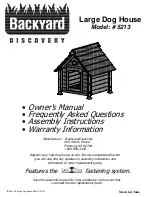
9
8
(Figure 3b)
Adjust the length of the strut such that the distal thigh strap
will not interfere with the popliteal region of the knee. Use the push
buttons to adjust the length and click them into place. Position the lower
thigh cuff in such a way that the bottom edge is located approximately
5 cm (2 in) above the top of the patella.
Note:
On shortest setting both push buttons may need to be engaged to
allow freedom of movement.
(Figure 3c)
Using the quick release pegs, adjust the flexion/extension
stops to the desired range of motion and secure the pegs with a quarter
turn twist until they lock back into position.
For a left setting of the brace:
• 90 degrees flexion / 0 degrees extension: place quick release pegs in
hole marked
“L”
and hole marked
“1”
and
“2”
(as shipped).
• 45° flexion: place quick release peg in holes L, 2 and 4.
For a right setting of the brace:
• 90 degrees flexion / 0 degrees extension: place quick release pegs in
hole marked
“R”
and hole marked
“3”
and
“4”
(as shipped).
• 45° flexion place quick release peg in hole marked R, 1 and 3.
Note:
While the brace is available as a left or right orientation, it can be
converted to the opposite orientation by reversing the Left (L) or Right
(R) pegs at the base of the hip plate, and readjusting the Flexion/
Extension stops for appropriate range of motion control. The brace will
be set at 90 degrees flexion and 0 degrees extension out of the box.
Thigh strap (Figure 4 & 5)
Secure the thigh strap into the keyhole receiver on the distal thigh plate.
If the thigh strap is too long, disengage the hook from the loop material,
cut the strap to the appropriate length, then re-secure the hook to the
loop material and lock the strap into the keyhole receiver.
The Rebound Hip brace has now been sized appropriately for your
patient.
Belt Positioning (Figure 6 & 7)
Remove one end of the folded belt arms from the Fitting Tool, position
around the patient’s waist, and then slide the belt arm loop back onto the
Fitting Tool.
Belt Adjustment (Figure 8–10)
Disengage the Crescent Velcro adjustments from the belt, pull away from
the Fitting Tool until snug, and then reapply the Velcro to the belt to hold
in place.
Note:
Ensure that the belt has not rotated on the torso and make any
adjustments necessary to line up the Fitting Tool along the patient’s mid-
point.
Remove the Fitting Tool from the belt, and the belt from the patient.
Apply the alligator clips on either belt end. The Fitting Tool has
maintained the correct distance between the two belt arms for proper
donning.
Brace Positioning (Figure 11)
Position the brace back onto the hip and apply the thigh strap to hold in
place. Position the belt with the pulley system at the patients back and
wrap the belt arms around the patient, covering the thigh pad on the
Summary of Contents for REBOUND HIP
Page 1: ...Instructions for Use REBOUND HIP...
Page 3: ...3 1 i h e f g k j a b c d 1 i h e f g k j a b c d 1 2 3 a...
Page 4: ...4 1 3 4 R L 2 b 3 3 4 c...
Page 5: ...5 5 6 7 8...
Page 6: ...6 9 10 11 l...
Page 7: ...7 1 2 3 4 5 6 13 14 12...










































